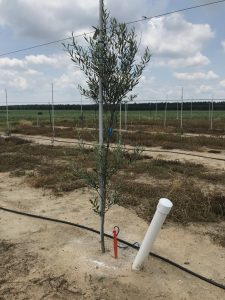By Breanna Kendrick
When olives began to be investigated as a potential crop for Florida, it made sense for Mack Thetford to be involved with the research. He has traditionally worked in plant propagation, dune restoration and evaluation of plants for drier landscapes, which is where olive trees are typically grown.
Thetford is an associate professor of environmental horticulture with the University of Florida (UF) at the West Florida Research and Education Center in Milton.
Thetford’s research is aimed at improving establishment of olive orchards in Florida. He has been working with a team of researchers to look at establishment of olives in North Florida and in North Central Florida around Citra.
Some people in Florida have been growing olives long enough that they are harvesting and squeezing oil. However, field research has just begun within the last couple of years. Thetford and other researchers are only in their second year of a tree-establishment experiment.
Thetford’s initial question is: Does the transplant size (how tall the tree is or how large the container volume is) at the time of planting influence transplant survival, or might it influence how quickly a tree can become productive? The research also seeks to determine what the basic fertility needs of olives are in Florida soils.
“We’re just now finishing up our first year in the ground with trees. They went through a nice cold winter, so we got some preliminary data on initial survival,” explains Thetford. “We are seeing some differences between the initial transplant size, and we’re also seeing initial differences between orchards planted in the northern part of the state versus the central/southern part of the state. I think by the end of our two-year study, we’ll be able to make some preliminary recommendations on transplant sizes.”
There are three different varieties that Thetford and his team are planting: Arbequina, Arbosana and Koroneiki. They’ll see if there’s a big difference between these varieties in initial transplant survival, tree growth and cold hardiness.
The research is also trying to determine what the basic nutrient requirements are for olives. This is important because when a soil sample is sent to the lab for a fertilizer recommendation, the lab must have a baseline of information for comparison. “We will publish the soil and plant nutrient information, and then our data will be available … so labs here in Florida will have a basis for making a recommendation for fertilizers in the future,” says Thetford.
It’s not yet known if olives can be successfully grown in Florida. While the focus of this research is to answer large-scale production questions, the research team has prepared a publication to assist homeowners with establishment and management of olives in Florida landscapes.
Thetford says he monitors the olives for pests and does basic treatments on the trees. “We haven’t really had any pest problems,” he states. Pest monitoring and management in olives is a research area of UF scientist Jennifer Gillett-Kaufman, who brings her knowledge on this subject to the research team. She has published a summary of the pests found in Florida-grown olives.
Share this Post









